In recent years, the gig economy has become a great alternative to traditional working models. Both freelancers and companies value the flexibility and lower commitment offered by this model.
One notable example of a successful freelance website is Upwork. Its widespread success story encourages aspiring entrepreneurs to launch similar platforms.
If you wonder how to build a website like Upwork, stay tuned. In this article, you will find out about the key phases of creating an online freelance marketplace. We will discuss such important aspects as value proposition, revenue model, required functionality, and the tech stack.
What is a freelance marketplace?
Before we delve into the process of building a website like Upwork, let’s discuss the definition of the term in question.
An online freelance marketplace is a two-sided platform where employers (both companies and individual clients) can hire individual specialists for specific projects.
Such websites have been on the rise in recent years. The shift from the standard 9-to-5 office routine to freelance work caused the demand for freelance marketplaces. The thing is that both employers and contractors needed a secure place to collaborate.
The other reasons for the growing popularity of services like Upwork are as follows:
- Easy access to talented specialists. Freelance marketplaces make it possible to hire skilled professionals from all over the world.
- Cost-effectiveness. Companies can hire professionals with the required skills without spending too much money.
- The possibility of hiring talents on demand. Companies hire contractors with a view of getting the desired outcome. If specialists or their work are unsatisfactory, there is always an opportunity to hire another professional.
The high demand for freelance marketplaces resulted in a growing number of websites like Upwork. The most famous ones include Fiverr, Toptal, and Freelancer.com.

Upwork is the biggest freelance marketplace
Today, we know Upwork as one of the oldest and most popular job sites for freelancers. Its story starts with two different freelance marketplaces called eLance and oDesk. They were founded in 1999 and 2003, respectively.
2013 was marked by the merging of these two websites into a single platform called Elance-oDesk. Finally, in 2015, the platform rebranding took place, and the website got its familiar name, Upwork.
Currently, Upwork lists over 10 million contractors and more than a million employers.
How does Upwork function?
The terms
In general, Upwork can be defined as a generic bidding marketplace, meaning that it consists of several parts:
- Generic. This means that employers can find contractors for any kind of project there, provided that the tasks can be performed remotely.
- Bidding. This term means that the candidates set the price of the services they consider fair, and the employers choose the best price offer.
- Marketplace. This notion supposes that, like in any other marketplace, there are two sides: buyers and sellers. Buyers are individual clients or companies that want to hire a specialist for a short- or long-term remote project. Sellers, in their turn, are freelancers who offer their services.
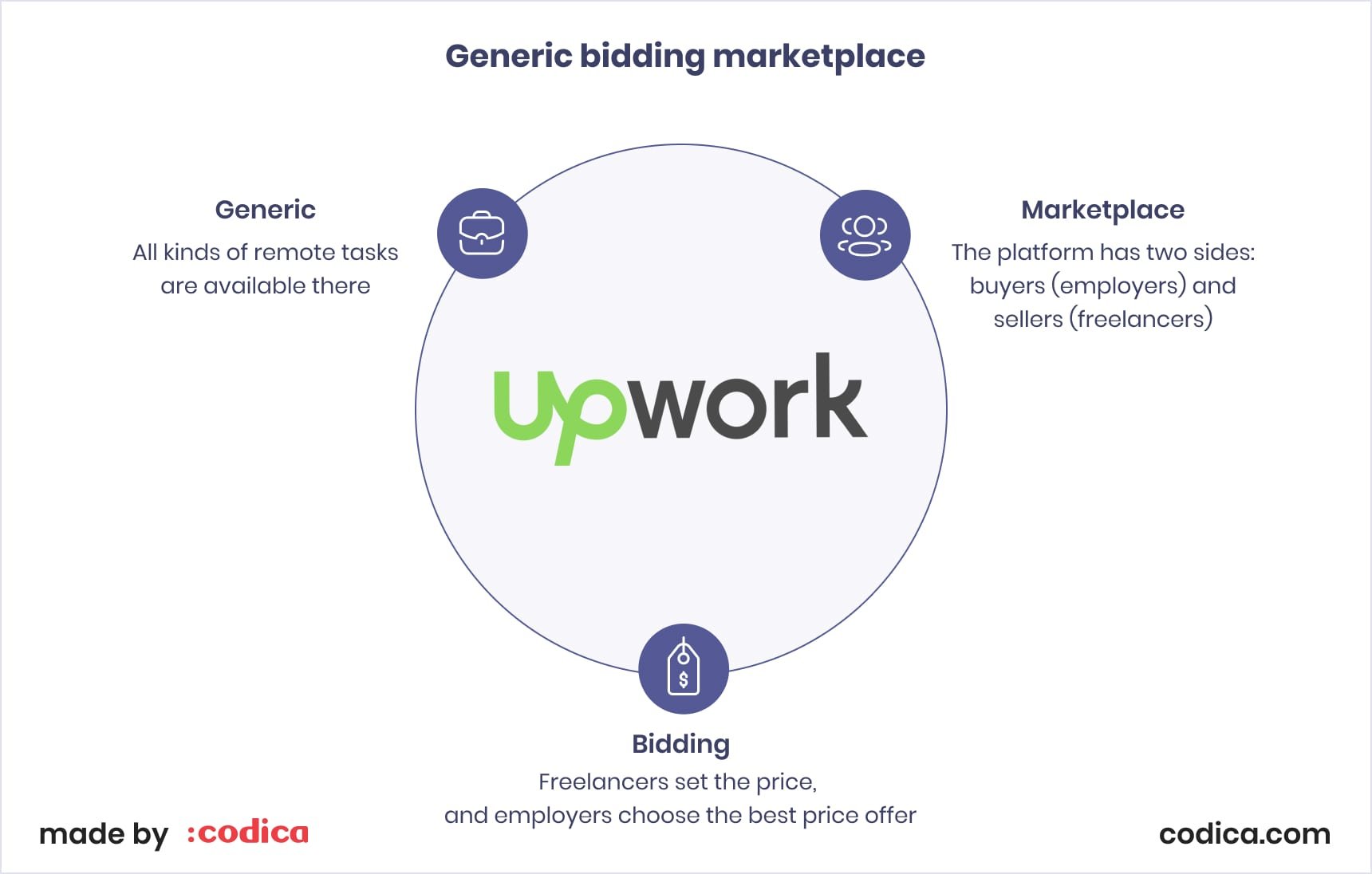
The process
Let’s see how the platform works using a specific example.
Suppose you need a freelance PWA developer for your development project. Here, you have two options.
1. Purchase of a pre-defined project completed by a specific developer. This is usually done by searching for a fitting candidate for the job. Employers can browse tons of profiles and look for people with portfolios with the most relevant experience, top ratings, and hourly rates.
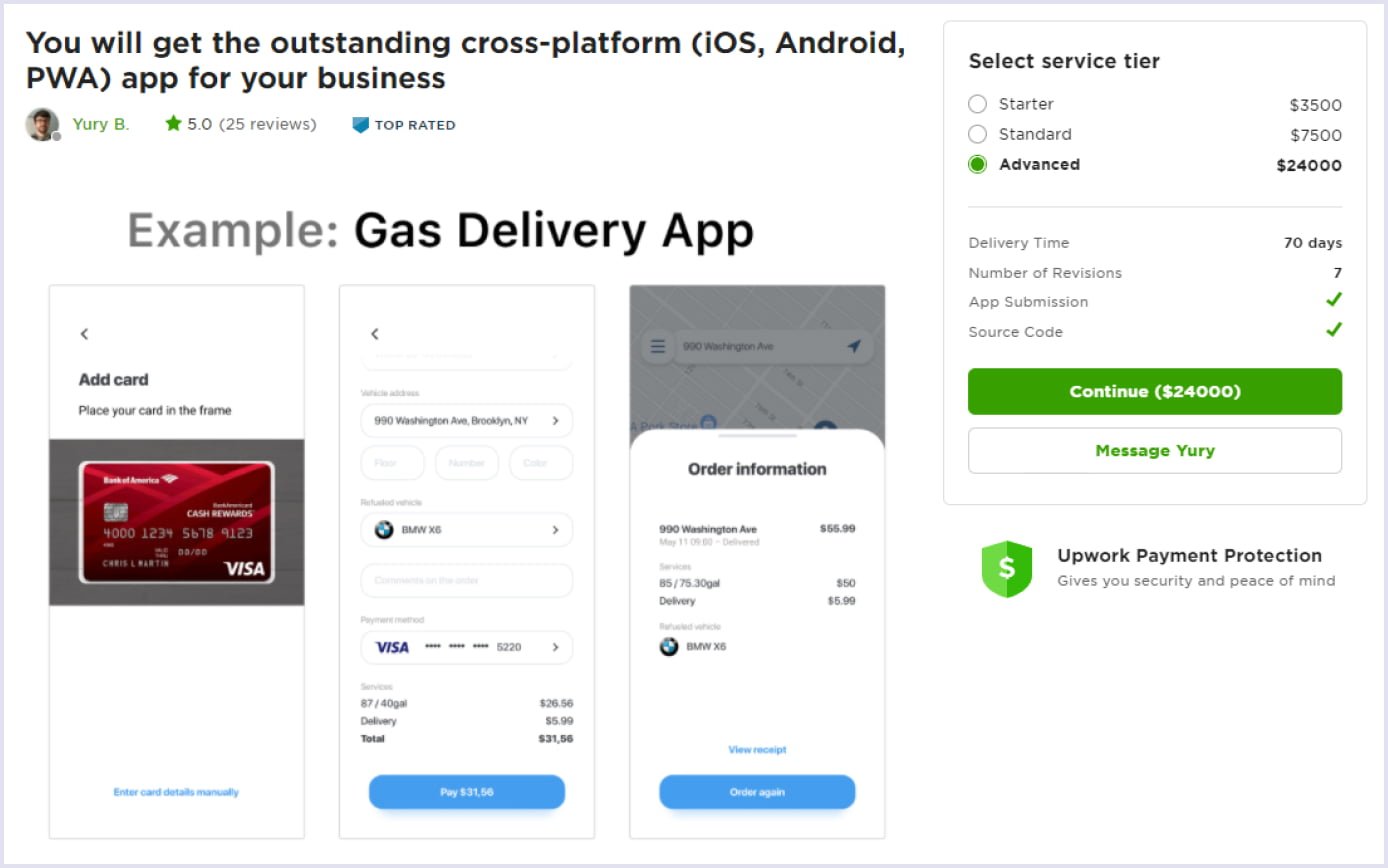
Source: Upwork
2. Hiring a developer for a custom project. Unlike in the first option, in this case, employers can create job postings first with specific requirements. Once the job is published, it becomes visible to all freelancers. They can apply for the position with their cover letter, resume, and portfolios and have a chance to be selected for the job.
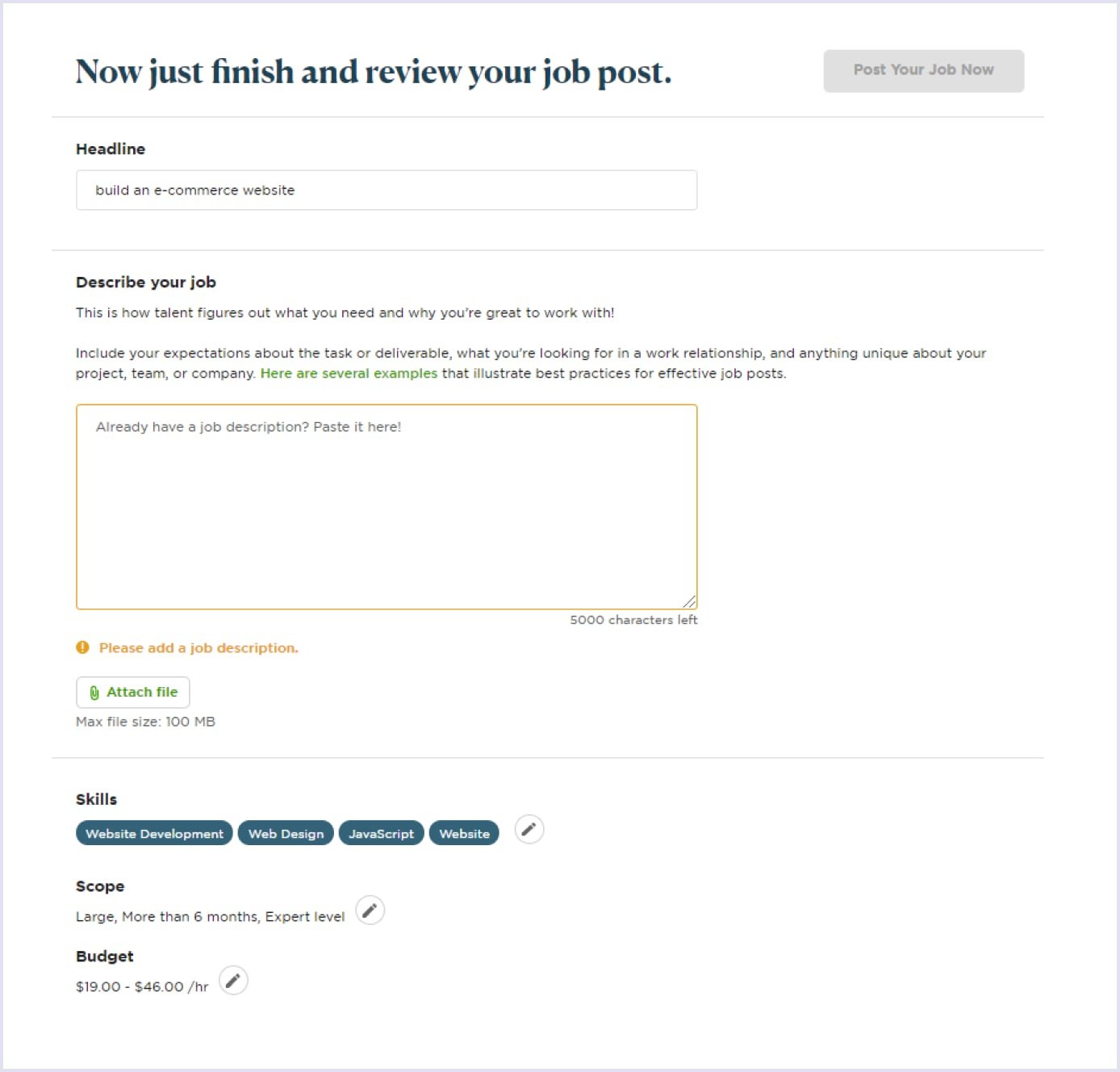
Source: Upwork
After all, this two-sided approach is quite flexible for people with varying needs. It lets both parties have a more comfortable way to get things done and establish themselves on the platform.
Revenue model
The time has come to discuss Upwork revenue models. You will launch your freelance marketplace to make money, therefore, you need to know the key monetization strategies for job sites like Upwork.
Basically, there are two main income streams for Upwork: service fees and premium subscriptions.
Service fees:
- Freelancers. They pay a 10% service fee on all earnings from contracts, regardless of their type. Notably, Upwork automatically deducts it from the freelancer’s earnings. For example, if a freelancer earns $500 from a project, they will pay a $50 fee and receive $450.
- Clients. They pay a Client Marketplace Fee of up to 7.99% on all payments made to freelancers. This fee covers fixed-price and hourly contracts, Project Catalog projects, bonuses, and other related payments.
Client membership:
Another Upwork revenue model implies offering businesses different subscription plans.
- Marketplace Plan. Clients pay a 5% service fee on all payments to freelancers. Eligible ACH payments are discounted to 3%.
- Business Plus Plan. Clients pay a 10% service fee on all payments to freelancers, with eligible ACH payments discounted to 8%. This plan includes additional features like premium 24/7 support and talent shortlisting services.
Main features for a marketplace like Upwork
Registration and user profiles
It’s the main place where freelancers and employers present themselves. Usually, a user profile includes a photo, bio, skills, and an overview of the completed projects.
Search system and filters
This feature is irreplaceable for helping businesses find a required specialist quickly and vice versa. Besides, your search functionality can be enhanced with AI, using technologies like Algolia or Weaviate. These tools help elevate user experience and make search routine intuitive and fast. As for filters, they allow hiring specialists that correspond to the specific requirements. The most common filters are domain, hourly rate, and skills.
Job listings
It is the main feature for businesses. Smartly built job listing functionality allows businesses to post contracts/jobs, provide necessary detail, clearly outline additional info, add attachments and more.
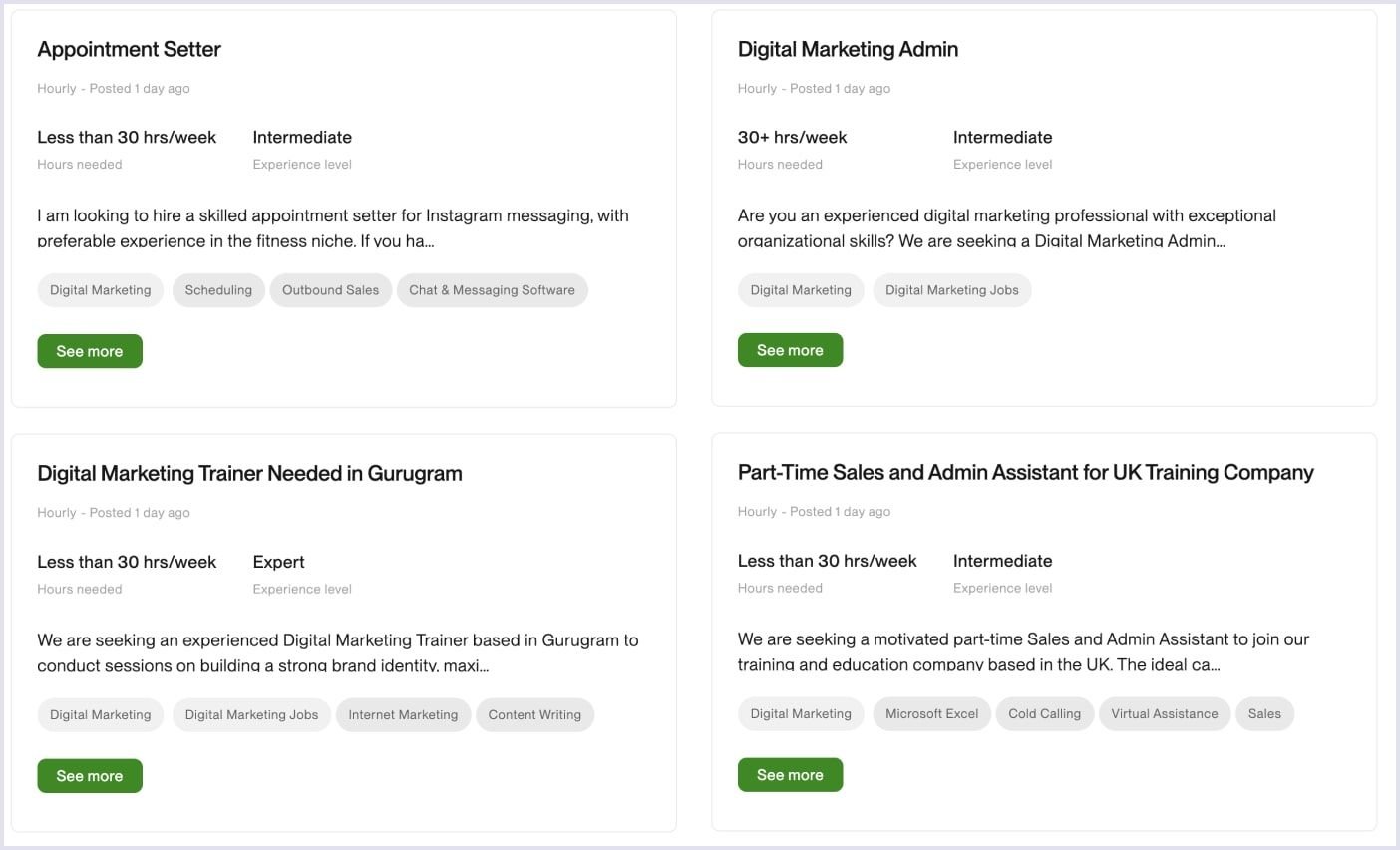
Source: Upwork
Bidding mechanism
Following the job listing feature, you must also implement a way to interact with them. Bidding functionality does just that. It lets contractors reply to relevant job postings, promote themselves, share their portfolios, and offer services.
Messenger
With messaging functionality, you can elevate collaboration effectiveness. Simply put, your users won’t need to leave the platform to discuss job-related matters, project details or work conditions. Thus, helping both parties stay in touch within the platform is crucial.
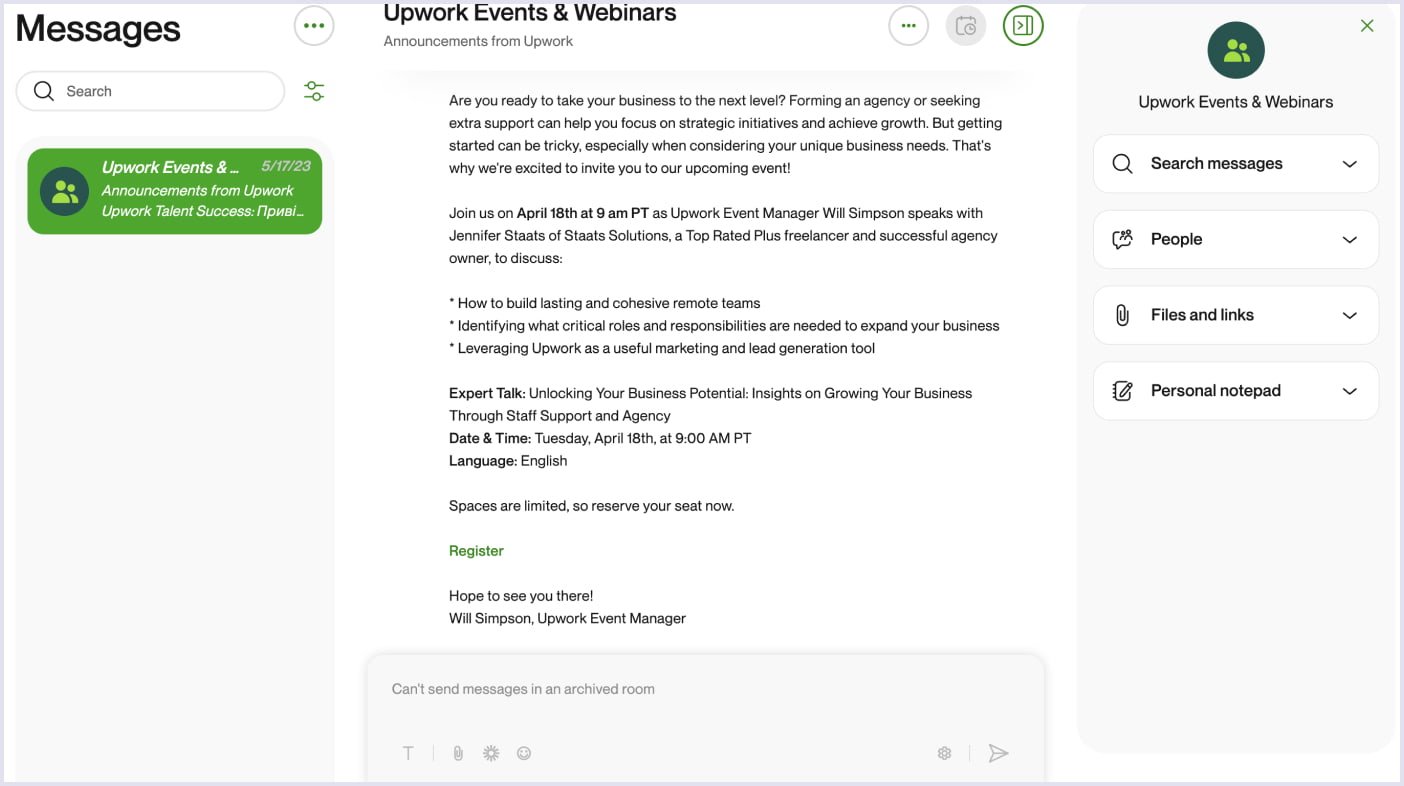
Source: Upwork
Review and ratings
Let your users, both employers and contractors, leave reviews about each other. This way, you will make your platform more trustworthy and provide additional clarity for both parties about each other.
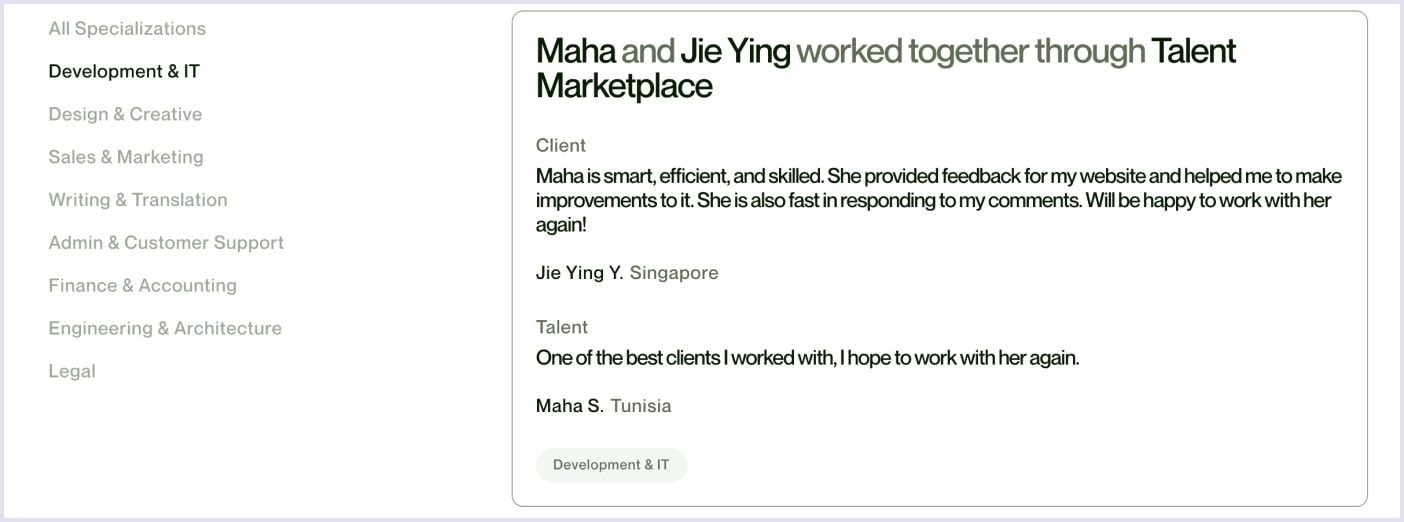
Payment gateways
As freelance platforms work across the world, a reliable and fast payment system is also a critical feature. For starters, consider offering multiple payment options, as well as types of payments, i.e., credit/debit cards, Apple/Google Pay, checks, cryptocurrency payments, and so on.
A step-by-step guide to building a marketplace like Upwork
Product discovery
Any product development starts with product discovery. It’s a natural first step where everything gets planned, outlined and researched. In the online marketplace development case, we do several things.
Choose your niche
First things first, think about your clients. Will they be individuals, small businesses, or large enterprises? What about freelancers? Will you attract specialists with rare skills or students looking for their first job?
Consider industries with growing demand, such as tech development, healthcare consulting, legal services, or niche creative fields like animation and game design. If your platform targets students and entry-level professionals, you might emphasize internship opportunities and beginner-friendly projects.
Conversely, if you’re catering to high-level experts, you may need to offer premium services, vetted memberships, or exclusive job postings for specialized professionals.
Notably, the niche you’re working in can dictate and define many other aspects, i.e., pricing models, features, and marketing strategies. Simply put, a platform for creative professionals might prioritize contest-based hiring, while a site for software engineers might focus on code collaboration tools and technical skill verification.
Read also: What is Project Discovery Phase in Custom Software Development
Define your value proposition
Your unique value proposition will highlight the benefits of your product and show its difference from other freelance platforms. Besides, you will be able to gain a competitive edge by covering the existing drawbacks in the specific niche.
When creating a unique value proposition, you can proceed from the following values you can offer to both parties of your freelance marketplace like Upwork.
- Accessibility. You have two options here. You can provide easy access and this way, create a large talent pool. The second approach implies restricted access. You filter freelancers based on their qualifications and skill set to leave only the very best candidates.
- Price. Analyze prices on other freelance marketplaces. Define how to lower the costs of particular services without cutting your margins.
- Time. Try to reduce the time required to receive payments. Thus, you will give freelancers a solid reason to join your site like Upwork.
Select the type of your freelance marketplace
To build a platform like Upwork that will bring you a stable income, define the type of your future job-related website. You can take the lead of Upwork or Freelancer and build a general freelance marketplace.
On the other hand, you can choose a different approach and create an industry-specific platform, which serves a particular niche. With the second option, for example, you get better chances to succeed since you will face less competition in the niche, but it may prove challenging to develop a platform that perfectly caters to the demand.
So, what are the most common types of freelance marketplaces? Let’s find out.
Local freelance marketplaces. They link together businesses and contractors located within a specific area. The most famous examples are NoCowboys and TaskRabbit.
Platforms focused on short-term jobs. Companies find contractors who will take on their single tasks on such platforms as Lorem and Fiverr.
Freelance marketplaces for long-term projects. Such platforms like Upwork are focused on long-termed projects that consist of multiple tasks. Apart from Upwork, such contracts can be found on Freelancer and Outsourcely.
Industry-specialized freelance portals. As the name suggests, these freelance marketplaces focus on a particular domain. For example, 99designers is a platform for freelance designers only, Codeable focuses on WordPress, and Verblio covers everything about writing.
Freelance platform for part-time jobs. Such freelance marketplaces allow college students and entry-level professionals to get their first job, gain experience, build portfolios, and earn income. In this matter, College Recruiter is a great example. Besides, FlexJobs and GigSmart platforms also provide part-time and gig-based work for individuals.
Enterprise-based marketplaces. Big companies turn to platforms like Toptal or Fiverr Pro to find specialists that match their specific demands. They often rely on custom enterprise software solutions for their unique requirements.
Contest platforms. On these crowdsourcing marketplaces, businesses post challenges, and freelancers submit their ideas to compete and get the job. Such challenges are popular in design, architecture, branding, as they offer clients multiple creative solutions to choose from. Some of the most popular platforms are Arcbazar (architectural design), DesignContest (graphic design), and NamingForce (business naming).
Below, you can see an example of live design competitions on Arcbazar.

Source: Arcbazar
Choose the revenue model
All freelance websites like Upwork employ some kind of monetization model to profit from client/contractor interactions. There are various ways to monetize your job-related platform. Here are some common revenue models.
- Gigs and packages model. This strategy allows freelancers to estimate their work and set their prices. Companies pay for the volume of services they find necessary.
- Subscription. Users pay a monthly fee to use the platform. As a rule, there are several subscription plans to fit any budget.
- Freemium model. Users get access to the platform for free, but their opportunities are limited. In case they need extra options, they pay an additional fee.
- Deposit model. Customers deposit money to get access to platforms like Upwork. If they are dissatisfied with the services offered, they get a refund.
- Advertisement. Freelancers can get their profiles highlighted and shown at the top of the list at an additional fee.
- Custom price. This monetization strategy is common for big clients with large complex projects. Standard fees may not work in such cases. For this reason, websites like Upwork provide their enterprise clients with special offers.
- Mixed model. You can combine several revenue models to offer users more flexible conditions for using your platform.

Choose the right technology stack
To build a website like Upwork that is reliable and scalable, you need to choose the right technology stack.
Let’s look under the hood and determine what programming languages, frameworks, and tools are used by Upwork.
Backend
When it comes to the server side, Upwork uses PHP and Java programming languages. However, you may choose any other technology that suits your project. For example, at Codica, we use Ruby and Ruby on Rails as the key tech stack for custom software development services.
Frontend
As for the client-side, Angular.js and Bootstrap were the ultimate choices for Upwork.
At Codica, we have a preferred tech stack that helps us build the frontend of web applications we deliver to our customers. It includes React, Vue.js, JavaScript, HTML5, and Gatsby.
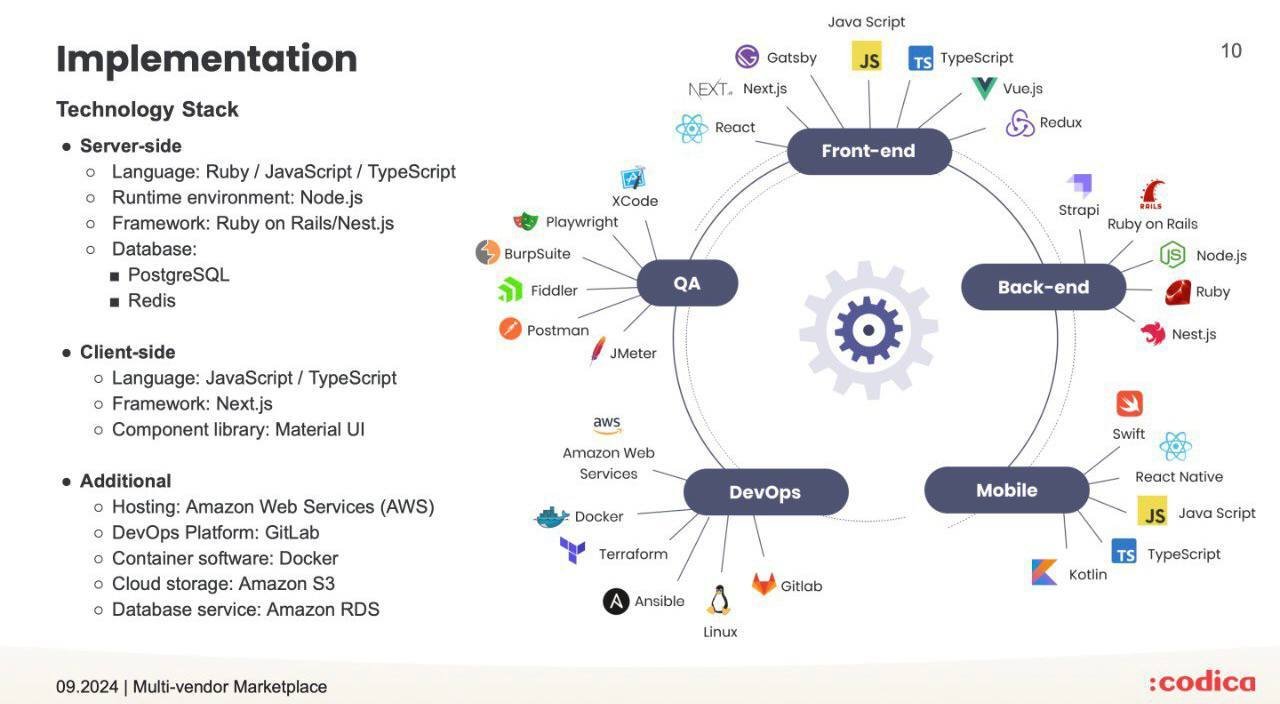
Third-party tools and integrations
It stands to be mentioned that the list of technologies and instruments used by Upwork is not limited to technical aspects only. Such tools and applications as Jira, Slack, Google Workspace, Marketo, and Zendesk help Upwork reach their business objectives.
Additionally, these can be tools for analytics and monitoring. As such, tools like Google Analytics (to track and report website traffic, user engagement, and key performance metrics), Mixpanel (to gain deeper insights into user interactions, refine features, and improve conversion rates), Grafana (to monitor and visualize the application’s performance, ensuring system reliability and quick issue resolution).
Besides, Upwork strongly emphasizes a robust search system. Being an indispensable element of this kind of marketplace, the search system is built with Elasticsearch. With its help, Upwork can fine-tune relevance with the help of advanced query structures and machine learning models that are built into the Elasticsearch environment.
Architecture
For a scalable and high-performing freelance marketplace like Upwork, right architecture is paramount. Among all possible options, like monolithic, layered, or serverless, MACH (microservices, API-first, cloud-native, headless) is the best choice.
While traditional architectures may work for small projects, MACH ensures long-term flexibility, better user experience, and seamless integrations. Thus, it is an ideal future-proof solution for a marketplace like Upwork.
Read also: Optimizing Ecommerce Performance and Scalability with MACH Architecture
UI/UX design
The UI/UX design for a freelance marketplace centers around delivering an intuitive, seamless, and engaging experience for both clients and freelancers.
Our UI/UX design services at Codica emphasize clarity, efficiency, and trust-building, ensuring users can easily accomplish core tasks, such as finding suitable projects or talent, negotiating terms, and completing transactions.
Notably, during this stage, we take several steps to ensure the final product looks as planned.
- Research. We study the client’s vision, analyze the target audience and competitors, and propose implementation ideas while keeping up with design trends.
- Prototyping. We develop grayscale prototypes to define structure and user flows, then create clickable versions for client review.
- Visualization. We gather references, design logos if needed, select fonts and colors, and finalize the project’s visual style.
- Design. We establish a design guideline detailing typography, colors, and UI elements, then design all pages for both desktop and mobile.
MVP development
Developing a full-scale product right away is an expensive and quite risky idea. Minimum viable product development services would be a fitting alternative. It encompasses only the primary and the most important features for your marketplace to operate.
Once the core functionality is developed, this simplified version gets tested with early adopters and refined according to the feedback. Ultimately, this approach safeguards business owners and lets them invest in a tested and safe idea.
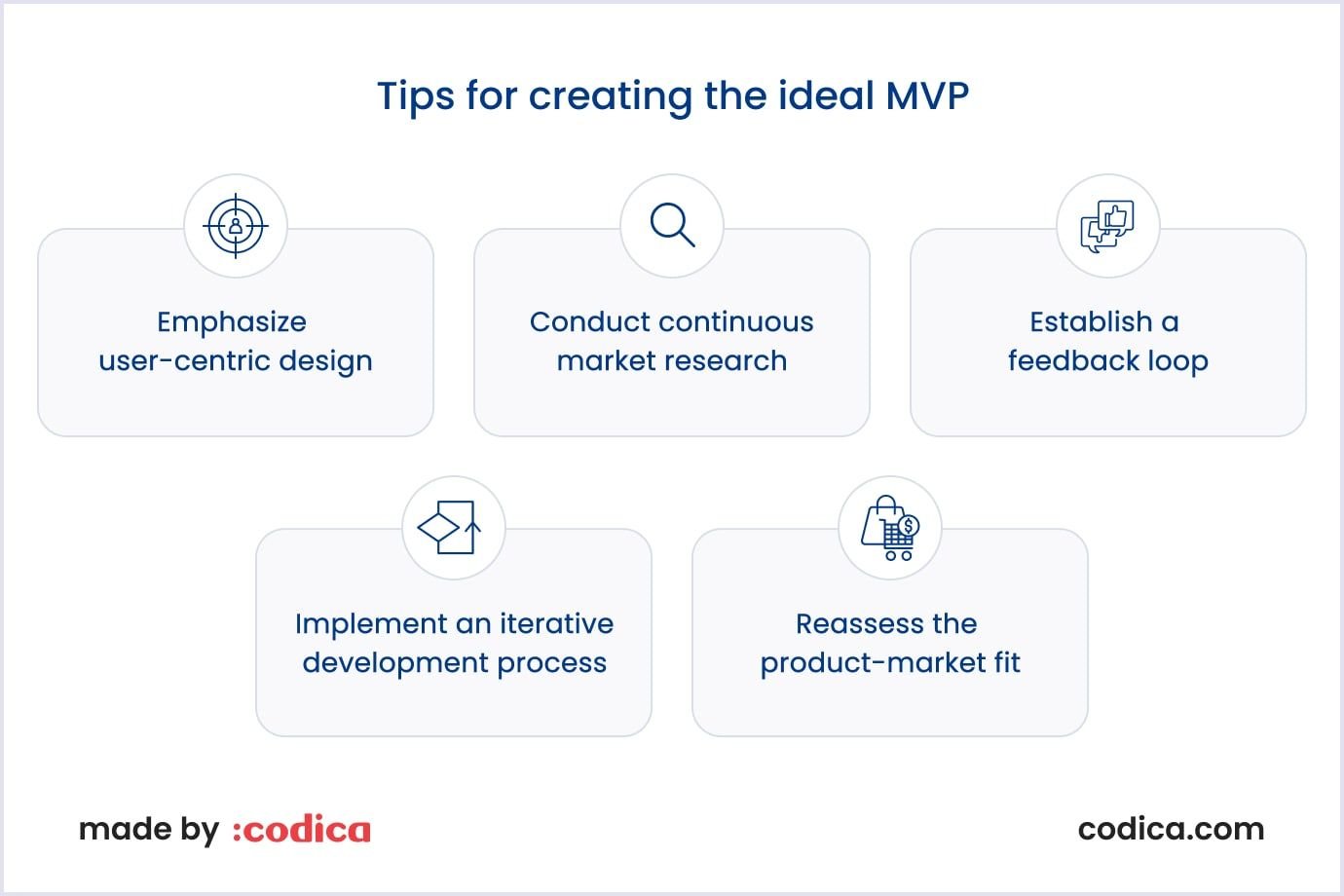
Quality assurance
Once the MVP is done, QA services for marketplace development then focus on ensuring platform reliability, stability, and seamless performance under real-world usage. Within this service, our specialists utilize many testing methods. Some of them are:
- Functional testing. Validate all core functionalities, ensuring each feature operates correctly and aligns precisely with business requirements and user expectations.
- Cross-browser and cross-platform testing. Ensure consistent performance across multiple browsers, operating systems, and devices, maintaining usability and accessibility for diverse users.
- Usability and user experience testing. Regularly conduct usability testing with real users to identify areas of friction, verify intuitive workflows, and continuously enhance overall user satisfaction.
- Performance and load testing. Assess platform performance under varying load conditions to ensure high availability, quick responsiveness, and seamless scalability as user traffic increases.
Read also: How Automation Testing Increases Execution Speed, Test Coverage, and Effectiveness
Deployment and maintenance
Once everything is done, launching a stable and continuously operational platform is no less important. The aim is to maintain reliability, security, and performance while introducing subsequent updates.
To achieve this, we efficiently automate deployment with CI/CD pipelines. They help streamline the release process and make it rapid, reliable, and consistent.
Besides, with cloud-based infrastructure management, we can handle fluctuating user traffic, guaranteeing platform availability and optimal performance at all times. Yet, continuous monitoring should never leave the picture. With monitoring tools and proactive alerting systems, we rapidly detect, diagnose, and resolve performance issues or potential downtime before users are impacted.
Last but not least, regular security updates and audits aren’t forgotten either. Our QA team continuously applies security patches, conducts regular vulnerability scans, and performs security audits to protect sensitive data transactions, and maintain compliance with industry standards.
The main challenges of the freelance marketplace platforms
No product is built without overcoming challenges. In the freelance marketplace domain, some of them can be quite common, be it for you as an owner or for your users. Thus, when it comes to building a platform like Upwork, the key challenges are as follows.
Preventing platform leakage
A common problem for freelance marketplaces is that clients and freelancers connect through the platform but later negotiate payments off-platform to avoid service fees.
This reduces the platform’s revenue and long-term engagement. Thus, some solutions include contract enforcement, offering value-added services, and introducing secure in-app payment guarantees.
Maintaining quality and preventing fraud
Freelance marketplaces often struggle with fake profiles, low-quality work, and scams. Without proper vetting systems, skill verification, and dispute resolution, clients may receive subpar work, and freelancers may deal with fraudulent clients. To negate this effect, platforms need robust verification, reputation systems, and AI-based fraud detection to maintain quality.
Managing customer support and dispute resolution
Freelance marketplaces must handle disputes between clients and freelancers, especially regarding project scope, payment disagreements, or missed deadlines. Establishing a clear dispute resolution system, including mediation, escrow protection, and transparent policies, is necessary to avoid reputational damage.
Achieving marketplace liquidity (i.e., balancing supply and demand)
One of the biggest hurdles is ensuring enough freelancers and clients are active on the platform. If there are too many freelancers and not enough job postings, workers will leave.
Conversely, if there aren’t enough skilled freelancers, clients won’t find the talent they need. Achieving a balance between supply (freelancers) and demand (clients) is critical for marketplace sustainability.
How much does it cost to build a website like Upwork?
When starting a business like Upwork, you, of course, want to know the required budget. To make things easier, we have created a table with the approximate costs of building a freelance marketplace.
In this estimate, we have used the main functionality for a website like Upwork and the average hourly rate of Eastern European software development agencies.
| How much does it cost to build a website like Upwork? | ||
| Features | Time, hours | Cost ($50/h) |
| Design | ||
| UX development | 64 | $3,200 |
| UI development | 96 | $4,800 |
| Architecture | ||
| Project setup | 16 | $800 |
| DB structure | 24 | $1,200 |
| Integrations | ||
| Payment (Stripe or PayPal) | 64 | $3,200 |
| Main functionality | ||
| Authorization and security | 16 | $800 |
| User profiles | 96 | $4,800 |
| Home page | 84 | $4,200 |
| Search and filters | 64 | $3,200 |
| Reviews and ratings | 96 | $4,800 |
| Messenger | 64 | $3,200 |
| Job listings | 64 | $3,200 |
| Job posting and bidding | 64 | $3,200 |
| Project management tools | 48 | $2,400 |
| Automatic gig and packages calculator | 48 | $2,400 |
| Freelancer panel | 80 | $4,000 |
| Employer panel | 80 | $4,000 |
| Admin panel | 96 | $4,800 |
| Non-development activity | ||
| Project management | 80 | $4,000 |
| Quality assurance | 96 | $4,800 |
| Code review | 48 | $2,400 |
| Total | 1388 | $69,400 |
So, we can say that the approximate cost of a freelance marketplace website like Upwork is $69,400, based on the rate of $50/hour.
The total amount of money you need to build a website like Upwork is defined by the functionality we discussed above. Your choice of a software development provider will also influence the required budget.
Please note that the above-mentioned numbers are only a rough estimate. Only your development agency will be able to provide you with the final cost of creating a freelance marketplace platform.

Conclusion
We hope that our detailed guide answers your question on how to make a website like Upwork. Now you can try your hand at launching a similar platform.
However,marketplace development can be a tall order for aspiring entrepreneurs. That is why we would recommend that you seek help from an experienced custom marketplace development company. Seasoned specialists will build a site like Upwork for you quickly and within your budget.
Codica team has successfully delivered multiple web products in various domains, feel free to check them out in our portfolio. We will gladly take on your project and create a freelance marketplace for you. Do not hesitate and contact us to turn your ideas into reality.
